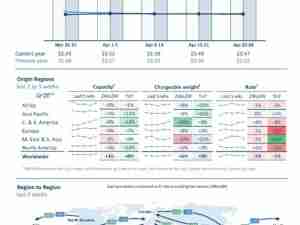Air cargo volumes have been more resilient to coronavirus pandemic-related effects than passenger traffic activity, but the overall effect on stabilizing airport revenues is mostly limited to the largest cargo hubs, given smaller cargo revenue contributions at the majority of US airports, says Fitch Ratings. At the 10-largest US cargo airports, passenger volumes were down 80%-90% in the initial period of peak declines after March 2020, while cargo volumes have seen more mild declines or, in a few cases, significant growth.
Despite the negative economic fallout of the pandemic, stay-at-home orders and increased ecommerce and online purchases have bolstered cargo volumes in the short-term. However, Fitch believes volumes could soften over the medium term due to global economic uncertainties. Historically, air cargo trends have exhibited a strong correlation with GDP growth, suggesting that volumes are susceptible to declines in the event of prolonged economic downturns.
Air cargo is frequently used to transport high-value, time-sensitive commodities and, more recently, personal protective equipment (PPE), ventilators and other medical equipment. Air cargo demand was driven by both urgency to obtain these supplies and the need to fill in for supply chains that had been disrupted due to stay-at-home orders and travel restrictions. Air cargo facilities are often financed by direct investments from the cargo carriers as opposed to the airport, limiting financial risk to airports with significant cargo operations, in contrast to facilities serving the passenger airlines at most of their hubs.
From January to May 2020, enplanements at the 10-largest US cargo airports by volume declined by approximately 50% compared with the prior-year period. By contrast, cargo volumes held steady and even increased at many of the large cargo hubs. Major cargo hubs such as Memphis International (MEM), Louisville Muhammad Ali International (SDF) and Cincinnati/Northern Kentucky International (CVG) were effectively flat in line with the prior year from January through May 2020 versus 2019. Miami International (MIA) and Los Angeles International (LAX) recorded moderate single-digit decreases in cargo volumes from January to May 2020, while Ted Stevens Anchorage (ANC) and Ontario International (ONT) recorded double-digit growth, partially bolstered by their West Coast proximity and ability to handle an increasing share of PPE originating from Asia.








